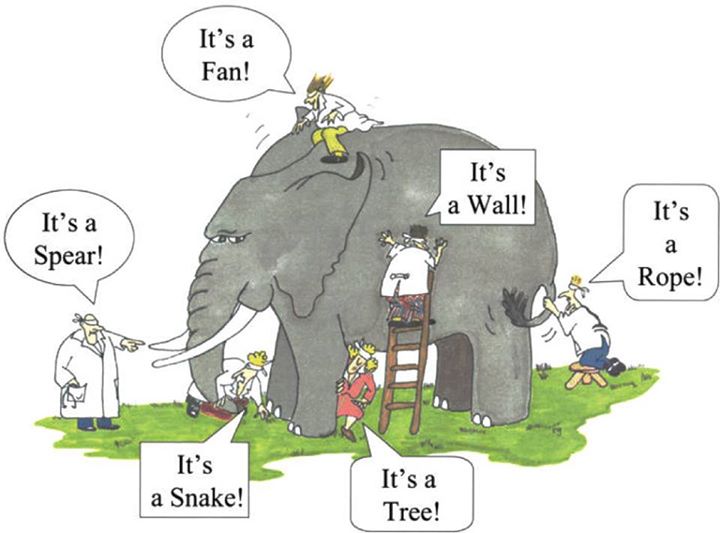CX operations, or customer experience operations, are all about the systems, automation, and lines of communication that make possible a unified, cross-functional approach to improving customer experience. Do you need a customer experience manager dedicated to managing this effort? Let’s find out.
Getting customers to fall in love with your company requires understanding the entire customer journey—so you can deliver a seamless experience at every touchpoint.
That’s not too tall an order if you are a young startup with only a handful of employees, all focused on customer experience (CX). After all, in those early stages, they have no choice but to study every step in the journey. By nature, a startup is all about the big picture.
However, as your company begins to scale, you may face the same challenges as large enterprises. CX efforts then become more specialized, and that’s when silos begin to form. Before you know it, you’ve got different departments using separate technologies and focusing on different metrics—fragmenting your understanding of the customer experience.
That’s when it’s time to consider hiring or appointing a CX manager. At this point, you need someone who can break down those silos, unify your tech stack, and unite your directors, VPs, and business units in the ultimate goal of creating a friction-free, productive, and delightful customer experience—from onboarding to renewal and advocacy.
What Is a Customer Experience Manager (CX Manager) ?
In order to understand what a CX Manager does—and why the role is so vital as companies scale—let’s picture a growing SaaS company, for example, that is considering adding this role. They’ve got a sales team focused on enterprise sales, a customer success team that largely spends its time making onboarding simple and straightforward, and a customer support team that’s available to fix problems. And of course, they’ve got a product team constantly working to improve their software with customers in mind.
Obviously, they have plenty of other departments, and each affects the customer experience to varying degrees (e.g., marketing, finance), but let’s focus on these four for the point of illustration. Each department has its own set of metrics, uses its own software, and focuses its attention on one specific leg of the customer journey.
The issue? You’ve got four different departments using different technology to record different metrics and measure their own aspect of the customer journey. It’s like the old story about the blind men who discover an elephant in the forest. They each know only one part of the elephant—the part they can touch—so nobody can agree what an elephant is actually like. After all, they’re each focused on a different body part (the trunk, the body, the leg, the tail).

So, let’s return to our original question:
The role of a CX manager is to determine, implement, and refine the CX technology and vision required to see the entire customer journey from the customer’s perspective.
This role determines the best way to collect, analyze, and act on voice of customer data at key touchpoints across the customer journey.
- Determine how, technically, to monitor sentiment at critical touchpoints. For example, what system “knows” when a user is “onboarded”? How can that data be used to trigger a request for feedback? In what customer experience management platform?
- Facilitate close-the-loop action. Enable stakeholders to respond to customer feedback quickly by moving feedback into the systems they use everyday.
- Democratize insight and action. This can mean creating CX dashboards that provide stakeholders with the ability to monitor and research what they care about. And, more importantly, to understand what actions they need to take in order to improve the over all customer experience.
So, What Does a CX Manager in Action Look Like?
The Salesforce Solution Architect and Senior Application Engineer who holds the cross-functional CX technology vision at Glassdoor shares, “The InMoment platform allows our Support team to segment feedback by agent and other relevant business drivers to uncover insights that contribute to optimizing our support function, and it can also reveal bottlenecks that are best addressed by improving product features or design.”
You can learn how Glassdoor, DocuSign, Hubspot and other InMoment customers tackle CX operations in this article, How to Use CX Metrics to Find Bottlenecks to Product-Led Growth, but here are a few quick pointers for now:
- Define a single source of truth for the voice of the customer (VoC). This can include determining where data will be aggregated into a single VoC feedback hub for research into and across journey points.
- Work with vendors and cross-functional stakeholders to implement the technology vision. Often this happens in a phased project approach, touchpoint by touchpoint.
- Keep the focus on the big picture—to understand that the elephant is more than the trunk, the body, the leg, or the tail.
Try as they might, individual departments have a hard time seeing the big picture since they’re so specialized (and are rarely incentivized by big picture metrics). That’s where the CX Ops manager or CX manager enters the picture.
What Kind of Background Should a CX Manager Have?
We’ve seen a wide range of candidates succeed in the role of CX manager—from Salesforce Administrators to Senior Sales Ops professionals to Customer Success or Customer Experience/VoC leaders. Even marketing folks have successfully led CX ops efforts.
It makes sense that good CX people would come from different backgrounds, since this role is about as cross-functional as it gets. What we can tell you is that there are certain qualities and skill sets, rather than specific career trajectories, that predict success in this role.
4 Qualities to Look for in a CX Manager
Quality #1: Diplomacy and Negotiation Skills
The person heading up CXOps must have some serious interpersonal skills, able to balance all the stakeholders’ needs and drives with the overarching goals and available resources. They’ll need to convince a range of departments—not just the customer-facing ones—just how vital these efforts are to the long term success of the company.
They will lead team meetings, communicate strategies, and move projects forward while holding everyone to a timeline (including executives). On top of that, they must be able to obtain a clear mandate and buy-in from their C-suite sponsors (or the head of CX, at the very least). In other words, they must possess both empathy and assertiveness in spades.
Quality #2: Deep Understanding of How the Tech Stack Works as a System
Your various technology platforms (Zendesk, InMoment, Gainsight, Salesforce, Slack, Segment, etc.) need to work together as a system. Otherwise, your information silos stay intact and your customer journey remains fragmented.
On top of that, they’ll need to find the gaps in your current capabilities and identify solutions to fill them. Sometimes this involves purchasing entirely new systems, other times it’s simply a matter of integrating what you’re currently working with. Usually, it’s a bit of both.
Quality #3: Project Management Mastery
Your Customer Experience Operations Manager will need some serious project management chops, including the ability to plan out timelines and budgets end-to-end (and get everybody to stick to them). They also need to know how to purchase from vendors without using an RFP.
Quality #4: A Strong Understanding of Procurement
“Let’s spend more money on systems just because we can!” Said no executive, ever.
Executives have grown wary of new B2B software that promises to solve all their problems, and middle-management is rarely overjoyed at the prospect of retraining staff on new platforms. That said, sometimes the current systems don’t cut it, and it’s up to the CX ops manager to understand the tradeoffs when evaluating new technology and delivering an integrated system that gets the job done.
Use Case: What a Fully-Integrated CX Initiative Looks Like
Every integrated CX initiative will look different depending on your existing technology, current integrations, and where you are in your growth cycle. That said, the following is a bird’s eye view of a solid CX initiative, and it should help get you started.
We’ll assume you have created a customer journey map and can tell your CX ops manager the make-or-break touchpoints that you want to optimize. You’ll also be responsible for forming a cross-functional team of stakeholders that are committed to improving the journey and to supporting the efforts of the CX manager.
Technology Needs Assessment
The CX ops manager should meet with each stakeholder team to understand:
- The technology they are using today
- Their CX data needs. This goes beyond metrics. It includes the customer data each team needs to make data segmentation and analysis useful. For example, support may need to associate customer satisfaction (CSAT) feedback with an agent. Success might need to know the user’s account, role, or pricing plan. Product may want to know how long a survey respondent has been a platform user.
Gather Voice-of-the-Customer (VOC) data (examples)
- Relationship data: Gather Net Promoter Score (NPS) data in-app or via email, or wherever you interact with customers.
- Onboarding data: Calculate Customer Effort Score (CES) from surveys following the WalkMe onboarding tour (via Segment event data or Salesforce workflows)
- Customer satisfaction data: Conduct CSAT surveys after Zendesk or Service Cloud case closures.
- Product satisfaction data: Collect PSAT data after feature use (in-app) and after closing the loop on customer service interactions (in chat or via email)
- Support tickets: The content of support inquiries is a source of VOC.
- Reviews: What are customers saying about your on Capterra or G2?
- Brand or user surveys: Any open-ended feedback from lengthy surveys.
Addressing Customer Pain Points and Closing the Loop
Strengthen the front line: Make it easy for teams to respond directly to customers by getting survey responses into the systems they live in. Populate the data in real time. For example, send InMoment survey responses to contact and account records in Salesforce for the sales team, to Intercom for Support, to Gainsight for Success or to Slack for the product team.
Leverage your happiest customers: Send review and referral requests to promoters via Marketo, HubSpot, or another customer communication platform like Intercom
Big Picture Analysis
- Create a roadmap: Allow qualitative feedback to drive your plan for CX improvement. Use it to understand the why behind the metrics, prioritize projects by predicting the potential impact on customer lifetime value. Build text analytics dashboards and reports that are customized for each team (support, success, Product, etc.) in your CXM platform. (Hint: InMoment can do this!)
- Centralize your data: Build a central voice of customer (VoC) repository for deep analysis. This can mean augmenting customer journey feedback with support ticket content, online reviews, and brand surveys.
- Integrate CX into business analysis: Export metrics and metadata to the company’s data lake/business intelligence tool.
| Note: It’s absolutely vital to use a CX management platform that integrates smoothly with new and existing systems. |
The Value of Executive Buy-in and Support
As you can see, the success of your integration efforts will rest largely on the shoulders of your new CX manager, who will have their finger on the pulse of the entire customer experience. They’ll connect departments that normally go days or weeks without interacting, so in order to set them up for success, they’ll need support from senior management.
Why is that so important? It’s all about in-group bias. It’s human nature to think of the world in terms of “us” vs. them,” or “our department” vs. “their department.” This potentially puts CX ops at odds with, well… literally every department they encounter—unless the executive sponsor puts those worried minds at ease.
With executive buy-in and support, the CX ops Manager will have the authority and credibility they need to suggest the (sometimes) sweeping changes that would otherwise produce fear and resentment in those who have grown comfortable in their silo. A supportive c-suite executive can assure skeptics that this is the natural evolution of their efforts to serve customers at every stage in the journey. In turn, this paves the way for long term growth and success for the organization as a whole.Customer Experience Operations leaders chose InMoment for customer experience management. Book a consultative demo today.








